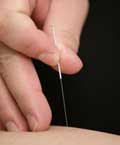New research demonstrates that a session of 12 acupuncture visits using electro-acupuncture improves functions in children with autism. Electro-acupuncture caused improvements in language comprehension and self-care ability for the children in this randomized, double-blind, sham-controlled, clinical trial of acupuncture for the treatment of autism spectrum disorder (ASD).
Electro-acupuncture also caused significant improvements in social initiation, receptive language, motor skills, coordination, and attention span. Improvements in motor coordination include better writing ability. Participants were better able to write words within set lines and squares. One participant had significant improvements in swimming ability and improvements in paper cutting were also noted. Interesting motor improvements include better walking posture, speed of walking, and ability to ascend and descend stairs.
Over 70% of the children with ASD were compliant and adapted easily to the acupuncture therapy while 8% were not compliant. This was the first study ever conducted using electro-acupuncture for ASD using a double-blind, randomized, controlled trial. Subjects from ages 3-18 participated in the study and children who had been taking anti-epileptic drugs or who had recently had acupuncture were excluded from the study.
Classic acupuncture points for the treatment of autism were chosen for the study. Sishencong (EX-HN1), YinTang (EX-NH3), Ear naodian (AT3), and Ear shenmen (TF4) were chosen as the primary acupuncture points. Neiguan (P6), Shenmen (H7), TaiChong (Lv3), and Sanyinjiao (Sp6) were selected as complementary acupuncture points. Children were in either in a supine or sitting position for the 30 minute acupuncture treatment. Sterile disposable .3 X 4cm (30 gauge) acupuncture needles were used and points were connected with a portable electro-acupuncture device. The investigational sham acupuncture points were chosen at a 3-5mm distance from the real acupuncture points. The treatment principle was to “to make the heart ‘unobstructed,’ regulate the liver, correct derangements or imbalances, enforce the emotion, dredge stasis, invigorate the spleen and kidney, and facilitate the source of vital function.”
References:
Altern Med Rev. 2010 Jul;15(2):136-46. Randomized controlled trial of electro-acupuncture for autism spectrum disorder. Wong VC, Chen WX. Department of Paediatrics and Adolescent Medicine, Queen Mary Hospital, The University of Hong Kong, Hong Kong, China.
American Psychiatric Association. Diagnostic Manual of Mental Disorders. 4th ed. Washington, DC: American Psychiatric Publishing, Inc.; 1994.
Wong V. Can acupuncture of the tongue help autism? Autism-Asperger’s Digest Sept-Oct 2002;18-19:25,29.
Haley SM, Coster WJ, Ludlow LH, et al. Pediatric Evaluation of Disability Inventory: Development, Standardization, and Administration Manual, Version 1.0. Boston MA: PEDI Research Group; 1992.
Uniform Data System for Medical Rehabilitation (UDSMR). WeeFIM System SM. Clinical Guide: Version 5.01. Buffalo, NY: University at Buffalo; 2000.
Schopler E, Reichler RJ, Renner BR. The Childhood Autism Rating Scale (CARS): For Diagnostic Screening and Classification in Autism. New York, NY: Irvington; 1986.


